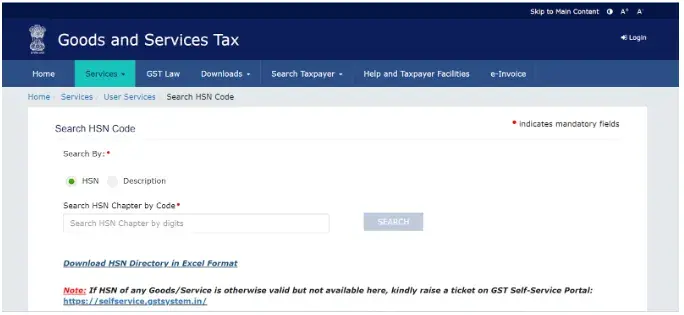Section I. Animals and Animal Products |
Chapter 1 | Animals |
Chapter 2 | Meat and edible offal |
Chapter 3 | Fish, molluscs, crustaceans, and other aquatic invertebrates |
Chapter 4 | Dairy produce, birds' eggs, honey and other edible products of animal origin that are not specified elsewhere |
Chapter 5 | Other products of animal origin that are not specified elsewhere |
Section II. Vegetables and Vegetable Products |
Chapter 6 | Live trees and plants, bulbs, roots, etc., cut flowers and ornamental foliage |
Chapter 7 | Edible vegetables, certain roots and tubers |
Chapter 8 | Edible fruit and nuts, the peel of citrus fruits or melons |
Chapter 9 | Tea, coffee, mate and spices |
Chapter 10 | Cereals |
Chapter 11 | Milling products, malt, wheat gluten, starches, and inulin |
Chapter 12 | Oil seeds and oleaginous fruits, grains, straw and fodder, seeds and fruit, and industrial or medicinal plants |
Chapter 13 | Lac, gum, resin, and other saps and extracts |
Chapter 14 | Vegetable plaiting materials, and vegetable products that are not specified elsewhere |
Section III. Animal or Vegetable Oils, Their Cleavage Products, Waxes, and Prepared Edible Fats |
Chapter 15 | Animal or vegetable oils, their cleavage products, waxes, and prepared edible fats |
Section IV. Prepared Food, Beverages, Spirits, Tobacco and Tobacco Substitutes |
Chapter 16 | Preparation of meat, fish or crustaceans, molluscs, or any other aquatic invertebrates |
Chapter 17 | Sugar and sugar confectionery |
Chapter 18x | Cocoa and cocoa preparations |
Chapter 19 | Preparations of cereals, starch, flour, milk, and pastry products |
Chapter 20 | Preparation of vegetables, fruits, nuts, or plant parts |
Chapter 21 | Miscellaneous edible preparations |
Chapter 22 | Beverages, vinegar, and spirits |
Chapter 23 | Residue and food waste, prepared animal fodder |
Chapter 24 | Tobacco and tobacco substitutes that are manufactured |
Section V. Minerals |
Chapter 25 | Salt, earths and stones, sulphur, plastering material, lime, and cement |
Chapter 26 | Ores, slag, and ash |
Chapter 27 | Mineral fuel, mineral oils and products of their distillation, mineral waxes, and bituminous substances |
Section VI. Chemical Products or of Allied Industries |
Chapter 28 | Inorganic chemicals, organic or inorganic compounds of precious metals, rare-earth metals, radioactive elements, or isotopes |
Chapter 29 | Organic chemicals |
Chapter 30 | Pharmaceutical products |
Chapter 31 | Fertilisers |
Chapter 32 | Tanning or dyeing extracts, tannins and their derivatives, dyes, pigments, and other colouring matter, varnishes and paints, inks, putty and other mastics |
Chapter 33 | Essential oils and resinoids, cosmetic or toilet preparations, perfumery |
Chapter 34 | Soap, washing preparations, organic surface-active agents, lubricating preparations, prepared waxes, artificial waxes, polishing or scouring preparations, candles and similar items, modelling pastes, dental preparations and dental waxes with a basis of plaster |
Chapter 35 | Albuminoidal substances, glues, enzymes, and modified starches |
Chapter 36 | Explosives, pyrotechnic products, pyrophoric alloys, certain combustible preparations, and matches |
Chapter 37 | Photographic or cinematographic goods |
Chapter 38 | Miscellaneous chemical products |
Section VII. Plastics, Rubber, and Articles Thereof |
Chapter 39 | Plastics and plastic articles |
Chapter 40 | Rubber and rubber articles |
Section VIII. Raw Hides and Skins, Furskins and Articles Thereof, Leather, and Related Goods |
Chapter 41 | Raw hides and skins (other than furskins) and leather |
Chapter 42 | Articles made of leather, travel goods, handbags and similar containers, saddlery and harnesses, articles made of animal gut (other than silkworm gut) |
Chapter 43 | Furskins and artificial fur and articles thereof |
Section IX. Wood and Wooden Articles, Wood Charcoal, Cork and Articles of Cork, Basket Ware and Wickerwork, Manufacturers of Straw, Esparto or Other Plaiting Material |
Chapter 44 | Wood and wooden articles, wood charcoal |
Chapter 45 | Cork and articles of cork |
Chapter 46 | Manufactures of straw, esparto or other plaiting materials, basket ware and wickerwork |
Section X. Pulp of Wood or Other Fibrous Cellulosic Material, Recovered Paper or Paperboard (Waste and Scrap), Paper and Paperboard and Articles Thereof |
Chapter 47 | Pulp of wood or other fibrous cellulosic material, recovered paper or paperboard (waste and scrap) |
Chapter 48 | Paper and paperboard, articles made of paper pulp, or articles made of paper or paperboard. |
Chapter 49 | Printed books, pictures, newspapers, and other products of the printing industry, typescripts, manuscripts, and plans |
Section XI. Textile and Textile Articles |
Chapter 50 | Silk |
Chapter 51 | Wool, fine or coarse animal hair, horse hair yarn and other woven fabrics |
Chapter 52 | Cotton |
Chapter 53 | Other vegetable textile fibres, paper yarn and woven fabrics made of paper yarn |
Chapter 54 | Man-made filaments |
Chapter 55 | Man-made staple fibres |
Chapter 56 | Wadding, felt and nonwovens, twine, cordage, special yarns, ropes, and cables and articles thereof |
Chapter 57 | Carpets and textile floor coverings |
Chapter 58 | Special woven fabrics, lace tapestries, tufted textile fabrics, trimmings, and embroidery |
Chapter 59 | Impregnated, covered, coated, or laminated textile fabrics, textile articles made for industrial use. |
Chapter 60 | Knitted or crocheted fabrics |
Chapter 61 | Articles of apparel and clothing accessories that are knitted or crocheted |
Chapter 62 | Articles of apparel and clothing accessories that are not knitted or crocheted |
Chapter 63 | Other made up textile articles, sets, worn clothing and textile articles, and rags |
Section XII. Footwear, Headgear, Umbrellas, Walking Sticks and Seat Sticks, Whips, Riding Crops and Parts Thereof, Artificial Flowers, Articles of Human Hair, Prepared Feathers and Articles Made Thereof |
Chapter 64 | Footwear, gaiters, etc., and the parts of such articles |
Chapter 65 | Headgear and parts thereof |
Chapter 66 | Umbrellas and sun umbrellas, walking sticks, seat sticks, riding crops and parts thereof, and whips |
Chapter 67 | Prepared feathers and down and articles made thereof, artificial flowers, and articles made of human hair |
Section XIII. Articles Made of Stone, Plaster, Asbestos, Cement, Mica, or Other Similar Materials, Glass and Glassware, Ceramic Products |
Chapter 68 | Articles made of stone, plaster, cement, asbestos, mica or similar materials |
Chapter 69 | Ceramic products |
Chapter 70 | Glass and glassware |
Section XIV. Natural or Cultured Pearls, Precious Metals Clad With Precious Metal and Articles Thereof, Precious or Semi-Precious Stones, Coins, Imitation Jewellery |
Chapter 71 | Natural or cultured pearls, precious metals, metals that are clad with precious metal and articles thereof, precious or semi-precious stones, imitation jewellery, coins |
Section XV. Base Metal and Articles Made of Base Metal |
Chapter 72 | Iron and steel |
Chapter 73 | Articles made of iron or steel |
Chapter 74 | Copper and articles thereof |
Chapter 75 | Nickel and articles thereof |
Chapter 76 | Aluminium and articles thereof |
Chapter 77 | (Reserved for possible future use) |
Chapter 78 | Lead and articles thereof |
Chapter 79 | Zinc and articles thereof |
Chapter 80 | Tin and articles thereof |
Chapter 81 | Other base metals, cermets, and articles thereof |
Chapter 82 | Tools, implements, spoons and forks, cutlery, of base metal, and parts thereof |
Chapter 83 | Miscellaneous articles made of base metal |
Section XVI. Machinery and Mechanical Appliances, Electrical Equipment and Parts Thereof, Sound Reproducers and Recorders, Television Image and Sound Reproducers and Recorders, and Parts and Accessories of Such Articles |
Chapter 84 | Nuclear reactors, machinery and mechanical appliances, boilers, and parts thereof |
Chapter 85 | Electrical machinery and equipment and parts thereof, sound reproducers and recorders, television image and sound reproducers and recorders, and parts and accessories of such articles |
Section XVII. Vehicles, Aircraft, Vessels, and Associated Transport Equipment |
Chapter 86 | Tramway or railway locomotives, tramway or railway track fixtures and fittings and parts thereof, rolling stock and parts thereof, mechanical (including electro-mechanical) traffic signalling equipment of all kinds |
Chapter 87 | Vehicles other than tramway or railway rolling stock, and parts and accessories thereof |
Chapter 88 | Aircraft, spacecrafts, and parts thereof |
Chapter 89 | Ships, boats and floating structures |
Section XVIII. Optical, Photographic, Cinematographic, Checking, Measuring, Precision, Medical or Surgical Instruments and Apparatus, Musical Instruments, Clocks and Watches, Parts and Accessories Thereof |
Chapter 90 | Optical, photographic, cinematographic, checking, measuring, precision, medical or surgical instruments and apparatus, parts and accessories thereof |
Chapter 91 | Clocks and watches and parts thereof |
Chapter 92 | Musical instruments, and parts and accessories of such articles |
Section XIX. Arms and Ammunition, Parts and Accessories Thereof |
Chapter 93 | Arms and ammunition, parts and accessories thereof |
Section XX. Miscellaneous Manufactured Articles |
Chapter 94 | Furniture, mattresses, mattress supports, bedding, cushions and similar stuffed furnishing, lamps and lighting fittings, which are not elsewhere specified or included, illuminated signs and name-plates and the like, prefabricated buildings |
Chapter 95 | Toys, games and sports requisites, parts and accessories thereof |
Chapter 96 | Miscellaneous manufactured articles |
Section XXI. Works of Art, Collectors’ Pieces and Antiques |
Chapter 97 | Works of art, collectors' pieces and antiques |
Chapter 98 | Project imports, laboratory chemicals, personal imports by air or post, passenger's baggage, ship stores |
Chapter 99 | Services |



